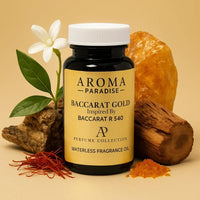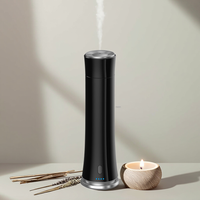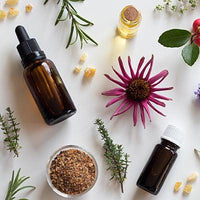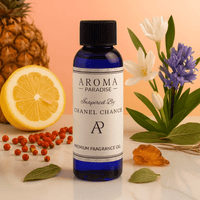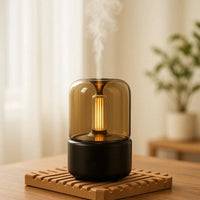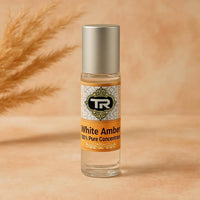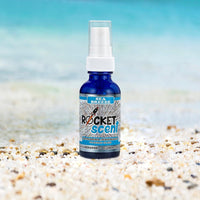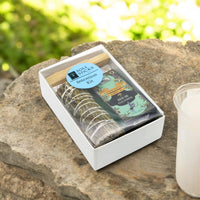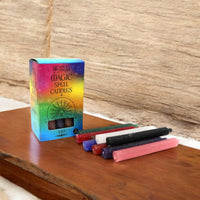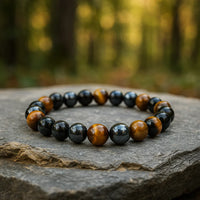Aroma Oil vs Essential Oil: What’s the Real Difference?
Share
Confused about which oil truly elevates your wellness routine, aroma oil or essential oil? You're not alone. While both fill our spaces with beautiful scents, they serve very different purposes. In today’s world of wellness, aromatherapy, and home fragrance, it’s common to hear terms like aroma oil, essential oil, fragrance oil, and even perfume oil being used interchangeably. However, these products are not the same. For anyone looking to make informed decisions, whether even if for personal wellness, skincare, or home scenting, understanding the real difference between aroma oil vs essential oil is crucial. At Aroma Paradise, we specialize in premium fragrance oils, and in this article, we break down every important aspect to help you choose wisely.
What is Aroma Oil?
Aroma oils, often referred to as fragrance oils or synthetic aroma oils, are typically a blend of synthetic aromatic compounds and sometimes natural essential oils. Unlike pure essential oils, aroma oils are primarily designed for their scent rather than their therapeutic benefits. The chemical composition of aroma oils allows for an extensive variety of fragrances that are difficult to achieve with natural plant extracts alone.
Aroma oils are widely used in candles, reed diffusers, wax melts, room sprays, perfumes, and bath products. Since they are formulated primarily for their aromatic qualities, they offer a consistent, long-lasting scent that remains stable over time. This stability and variety are why many industries prefer aroma oils for creating specific fragrance profiles.
Another key advantage of aroma oils is their extended shelf life compared to essential oils. Because they are often chemically stabilized, aroma oils resist oxidation and degradation, making them a cost-effective and reliable choice for manufacturers and consumers who prioritize scent over therapeutic effects.
What is Essential Oil?
Essential oils are pure, natural plant extracts obtained through methods like steam distillation, cold pressing, or solvent extraction. They capture the plant’s aromatic compounds along with its therapeutic properties. Unlike aroma oils, essential oils offer a complex chemical structure rich in terpenes, esters, ketones, aldehydes, and other bioactive components, making them highly effective in aromatherapy and holistic wellness practices.
Popular essential oils include lavender, peppermint, eucalyptus, tea tree, and lemon, each offering specific therapeutic benefits. Essential oils are often used for:
-
Aromatherapy (stress relief, relaxation, mood enhancement)
-
Skincare (acne treatment, anti-aging, inflammation reduction)
-
Health support (immune boosting, respiratory aid, digestive support)
-
Natural cleaning (antimicrobial properties)
Because of their purity, essential oils must be used with care. They are highly concentrated and often require dilution with carrier oils like jojoba, coconut, or almond oil before topical use. The therapeutic benefits of essential oils have been studied extensively, making them a cornerstone of holistic medicine and natural healing.
Extraction Methods: Natural vs Synthetic
The process by which these oils are made plays a major role in their properties.
-
Essential oils are extracted using natural methods:
-
Steam distillation: Used for plants like lavender, eucalyptus, and peppermint.
-
Cold pressing: Used for citrus oils like lemon and orange.
-
Solvent extraction or CO₂ extraction: Used for delicate flowers like jasmine or rose.
-
Aroma oils, on the other hand, are often created in laboratories. They combine synthetic aroma compounds with carrier oils or diluents to mimic natural scents or create entirely new fragrances not found in nature.
This distinction in production methods greatly affects their purity, therapeutic value, and suitability for different applications.
Key Differences Between Aroma Oil and Essential Oil
While both aroma oils and essential oils are used for their pleasant scents, they differ significantly in composition, usage, and benefits:
-
Composition:
-
Essential oils are 100% pure plant extracts.
-
Aroma oils are often synthetic or blended with some natural components.
-
Purpose:
-
Essential oils provide therapeutic benefits.
-
Aroma oils focus on delivering long-lasting fragrance.
-
Usage:
-
Essential oils are used in aromatherapy, skincare, and natural healing.
-
Aroma oils are primarily used in home fragrances, candles, cosmetics, and personal care products.
-
Safety:
-
Essential oils require dilution for safe topical use.
-
Aroma oils are typically not recommended for skin unless specifically formulated.
-
Cost:
-
Essential oils are generally more expensive due to the labor-intensive extraction process.
-
Aroma oils are more affordable and widely accessible.
Understanding these differences helps consumers choose the right oil based on their needs.
Common Uses for Aroma Oils
Aroma oils excel in creating inviting, consistent, and customized scents for homes and personal care products. Common uses include:
-
Scented candles and wax melts
-
Reed diffusers and room sprays
-
Soaps, lotions, and body washes
-
Perfumes and personal fragrances
-
Automobile air fresheners
-
Commercial scent marketing
Because they are chemically stable and offer endless scent possibilities, aroma oils are heavily used by industries seeking specific fragrance profiles. Their versatility makes them a popular choice for non-therapeutic applications.
Common Uses for Essential Oils
Essential oils serve a wide range of wellness, therapeutic, and household purposes:
-
Aromatherapy for stress and anxiety relief
-
Massage oils and pain relief creams
-
Skincare formulations for acne, wrinkles, and inflammation
-
Respiratory support during colds and flu
-
Natural household cleaning solutions
-
Immune system support through inhalation or diffusion
Essential oils offer holistic benefits that extend far beyond their pleasant aromas, making them a preferred choice for many practitioners of natural health and wellness.
Can You Use Aroma Oil in a Diffuser?
Yes, you can use aroma oils in certain types of diffusers, but caution is necessary:
-
Ultrasonic diffusers: Best suited for essential oils because they preserve therapeutic properties.
-
Nebulizing diffusers: Designed strictly for essential oils due to purity.
-
Heat or fan diffusers: Can accommodate aroma oils but may reduce scent quality over time.
-
Reed diffusers: Suitable for both aroma oils and essential oils when properly formulated.
However, some synthetic aroma oils may contain additives that can clog diffusers or degrade diffuser parts. Always ensure you use diffuser-safe fragrance oils, like those available at Aroma Paradise, which meet strict safety standards.
Aroma Oil vs Essential Oil in Skincare
When it comes to skincare, the choice between aroma oils vs essential oils requires careful consideration:
-
Essential oils offer proven therapeutic benefits for skin but must always be diluted before application.
-
Aroma oils are generally not suitable for direct skin application unless specifically formulated and tested for cosmetic use.
-
Products adhering to IFRA (International Fragrance Association) standards, like those sold by Aroma Paradise, ensure safe levels of fragrance ingredients for topical products.
For therapeutic skin benefits, pure essential oils remain the superior option.
Quality Standards and Labeling: What to Look For
When buying either aroma oils or essential oils, always check for:
-
Essential oils:
-
Botanical name (e.g., Lavandula angustifolia for lavender).
-
Extraction method and country of origin.
-
Purity (100% essential oil, no additives).
-
Aroma oils:
-
Full ingredient list.
-
IFRA compliance.
-
Safety guidelines for use.
Avoid products with vague labeling or "proprietary blends" without ingredient transparency. At Aroma Paradise, we believe in full disclosure and quality assurance for every product.
How Aroma Paradise Ensures Purity and Safety
At Aroma Paradise, we are committed to providing both high-quality fragrance oils and therapeutic essential oils:
-
Sourcing from trusted suppliers committed to ethical, sustainable farming.
-
Rigorous GC/MS testing for essential oil purity.
-
IFRA-certified formulations for aroma oils.
-
Transparent labeling with complete ingredient disclosure.
-
Compliance with international safety standards ensures our customers can shop with confidence.
Our dedication to quality makes us a trusted name in the fragrance oils industry.
FAQs
Are aroma oils safe for diffusers?
Yes, but only if they are formulated for diffuser use. Always check the label and use trusted sources like Aroma Paradise.
Can you mix aroma oils and essential oils?
In some cases, yes, but it requires expert knowledge to ensure safety and fragrance compatibility.
Which is better for aromatherapy?
Essential oils are superior for therapeutic aromatherapy due to their bioactive compounds.
Are aroma oils toxic?
Quality aroma oils from reputable brands following IFRA standards are safe for their intended use, but not for ingestion or therapeutic use.
Do aroma oils contain essential oils?
Some aroma oils are blended with a small percentage of essential oils to enhance their fragrance profile.
Suggestions: Which Should You Choose?
In the debate of aroma oil vs essential oil, your choice depends entirely on your purpose. If you seek therapeutic benefits for mind, body, and wellness, pure essential oils are your best choice. If your goal is simply to fill your home with luxurious, long-lasting fragrances, aroma oils or fragrance oils are ideal.
At Aroma Paradise, we proudly offer both, ensuring you receive the highest quality products whether you’re creating a relaxing sanctuary or exploring natural wellness through aromatherapy. Always choose wisely, and always choose purity.


